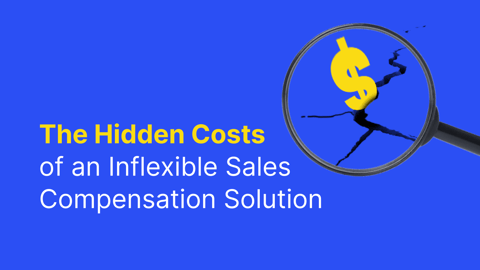Unlock The Full Potential of Your Salesforce
In today's dynamic business environment, achieving resilient and profitable growth is a paramount objective for organizations worldwide. This blog delves into the critical role of incentive compensation and sales performance management in driving revenue growth, enhancing resilience, and maximizing profitability.
The ability to adapt and thrive amidst uncertainty is crucial for long-term success. Organizations must navigate through various challenges while staying focused on their growth objectives. Strategic incentive compensation and sales performance management play a pivotal role in this journey by aligning employee efforts with business goals, fostering a culture of accountability, and optimizing performance.
The Challenge of Revenue Maximization
The Landscape: Amidst escalating revenue targets, organizations face the ongoing challenge of aligning individual and team efforts with overarching business objectives. Incentive compensation plans serve as vital tools, comprising a substantial portion of total revenue.
The Complication: Designing, administering, and managing effective sales incentive programs pose significant challenges. Without strategic intervention, these hurdles can lead to excessive spending without commensurate performance improvements.
The Impact: Suboptimal incentive programs result in misaligned behaviors, overlooked revenue opportunities, and diminished confidence among sales teams regarding the correlation between their efforts and financial rewards.
In this competitive landscape, maximizing revenue while maintaining profitability is a constant struggle. Organizations must strike a delicate balance between incentivizing sales teams to achieve ambitious targets and ensuring that compensation strategies align with the broader business objectives.
Strategic incentive compensation management addresses these challenges by providing a framework for designing, implementing, and optimizing incentive programs that drive revenue growth while safeguarding profitability.
The Complexities of Incentive Compensation
Data-Driven Dilemmas: Handling a multitude of data points and variables in compensation calculations can be daunting. The absence of streamlined processes often results in errors, delays, and resource drains.
Evolving Business Dynamics: The rapid pace of change in today's business landscape necessitates constant adaptation of incentive plans. Aligning compensation strategies with evolving market dynamics and internal shifts is crucial to bridge the gap between strategy and execution.
Communication and Transparency: Lack of clarity regarding performance-compensation correlation hampers motivation and impedes the cultivation of a performance-driven culture. Effective communication and transparency are essential for fostering engagement and alignment.
As organizations strive to remain agile and responsive to market changes, managing the complexities of incentive compensation becomes increasingly challenging. Data-driven insights, coupled with transparent communication, are essential for designing incentive programs that motivate employees and drive desired behaviors. Moreover, organizations must continuously adapt their compensation strategies to align with evolving business dynamics and maintain a competitive edge in the market. See how you can design more effective sales plans through an interactive product tour, to help respond to market changes.
The Imperative for Strategic Transformation: Agile Compensation Management
Strategic Alignment: Viewing compensation as a strategic enabler rather than a mere expense is imperative. Aligning incentive plans with overarching business strategies motivates behaviors that directly contribute to revenue growth and organizational success.
Adaptability and Agility: The ability to swiftly adjust incentive plans in response to market changes is indispensable. An agile compensation management approach enables proactive responses to opportunities and challenges.
Data-Driven Decision-Making: Leveraging data-driven insights enhances the efficacy of compensation strategies. Transitioning from reactive to proactive decision-making ensures that compensation initiatives are not only responsive but anticipatory.
In this rapidly evolving business landscape, organizations must undergo strategic transformation to remain competitive and drive sustainable growth. This transformation involves aligning incentive compensation strategies with broader business objectives, fostering agility and adaptability, and leveraging data-driven insights to make informed decisions. By embracing strategic transformation, organizations can position themselves for success in the face of uncertainty and complexity.
Unveiling the Solution: AI Sales Incentives and Planning
AI-Driven Insights: Incentives leverages advanced artificial intelligence to provide unparalleled insights, empowering organizations with comprehensive visibility into critical data.
Dynamic Incentive Flexibility: With Incentives, organizations can innovate their compensation strategies dynamically, fostering creativity and alignment with business objectives.
Rapid Plan Agility: Incentives ensures swift plan adjustments to accommodate market dynamics and internal shifts, streamlining plan administration and enabling proactive responses.
As organizations seek innovative solutions to enhance their incentive compensation management, technology plays a crucial role in driving efficiency and effectiveness. AI-driven insights provide organizations with the visibility and intelligence needed to optimize incentive programs, while dynamic flexibility enables them to adapt quickly to changing market conditions. Rapid plan agility ensures that organizations can respond promptly to emerging opportunities and challenges, maintaining a competitive edge in the market.
Transformative Value of Incentives: Aligning GTM Strategy and Seller Behaviors
Transparent Synergy: Incentives fosters transparency across the compensation process, seamlessly aligning with the goals outlined in the go-to-market (GTM) strategy.
Efficiency Amplified: By reducing manual effort and streamlining processes, Incentives enhances efficiency, allowing resources to be reallocated towards strategic alignment with the GTM strategy.
Optimized Performance: Leveraging AI-driven insights, Incentives optimizes salesforce performance, aligning seller behaviors with the GTM strategy for effective execution of growth plans.
With market competition at an all-time high, aligning sales strategies with go-to-market (GTM) strategies is essential for driving sustainable growth. Incentive compensation programs that seamlessly integrate with GTM strategies enable organizations to align seller behaviors with broader business objectives, fostering transparency, efficiency, and optimized performance. By leveraging AI-driven insights, organizations can optimize their salesforce performance, ensuring that every incentive dollar is invested strategically to maximize revenue and profitability.
Driving Resiliency with Strategic Compensation Management
Strategic compensation management fuels organizational resilience by aligning incentives with both profitability and revenue growth objectives.
Sustaining Growth: It ensures sales teams stay focused on activities driving revenue and profitability, sustaining growth trajectories.
Adapting to Markets: Organizations swiftly adapt to market dynamics, capitalizing on emerging opportunities and maintaining momentum amidst shifts.
Optimizing Efficiency: Resources are allocated effectively, maximizing salesforce productivity and revenue generation.
Cultivating Success: A culture of success is reinforced, aligning incentives with behaviors driving both short-term results and long-term success.
Retaining Talent: High-performing individuals are rewarded and retained, ensuring continuity and stability in achieving business objectives.
Organizational resilience is key to long-term success in an unpredictable market. Strategic compensation management plays a crucial role in fostering resilience by aligning incentives with both profitability and revenue growth objectives. By sustaining growth, adapting to market changes, optimizing efficiency, cultivating success, and retaining top talent, organizations can build resilience and thrive amidst uncertainty.
Cost Maximization: ROI of Incentives
Effective incentive compensation management maximizes the return on investment (ROI) by aligning compensation spending with revenue growth and strategic objectives, thereby optimizing profitability.
Strategic Spending Allocation: Through data-driven insights and analytics, organizations can allocate compensation budgets strategically, focusing resources on high-impact initiatives and sales channels.
Risk Mitigation: By aligning incentives with performance metrics and strategic objectives, organizations mitigate the risk of overspending on underperforming areas, ensuring optimal resource allocation.
Measuring ROI: Advanced analytics and reporting capabilities provided by incentive compensation management solutions enable organizations to measure the ROI of incentive programs accurately, facilitating informed decision-making and continuous improvement.
Maximizing the return on investment (ROI) of incentive compensation programs is essential for optimizing profitability and driving sustainable growth. Effective incentive compensation management enables organizations to align compensation spending with revenue growth and strategic objectives, ensuring that every dollar invested in incentives contributes to the bottom line.
Strategic Compensation Management FAQs
Q: How does strategic compensation management contribute to organizational resilience?
A: Strategic compensation management ensures that incentive plans are adaptable to changing market conditions, enabling organizations to respond swiftly to disruptions and maintain stability.
Q: How can organizations navigate uncertainty with strategic compensation management?
A: Strategic compensation management provides stability and assurance to the salesforce during times of economic volatility or industry upheavals, fostering confidence and commitment to organizational goals.
Q: How does strategic compensation management help in maintaining competitive advantage?
A: By aligning incentives with strategic objectives, organizations cultivate agile and responsive teams capable of driving innovation, customer satisfaction, and market leadership, thereby staying ahead of competitors.
Q: How does incentive compensation management maximize ROI?
A: Incentive compensation management maximizes ROI by aligning compensation spending with revenue growth and strategic objectives, strategically allocating resources, mitigating risks, and enabling accurate measurement of program effectiveness.
Incentives: The Future of Strategic Compensation
We've explored the challenges of incentive compensation and introduced Incentives as a transformative solution for strategic compensation management. By embracing Incentives' AI-driven insights, dynamic flexibility, and rapid plan agility, organizations can unlock resilient and profitable growth. Through strategic compensation management, organizations can drive resiliency, optimize costs, and align incentives with revenue growth objectives, paving the way for sustained success in today's competitive landscape.
In partnership with Varicent, the Sales Management Association put together an industry-leading research report that includes data from hundreds of sales leader professionals.
Download the report for an eye-opening look at where the sales performance market currently stands, and how you can set up your team for success in this change-intensive environment.



